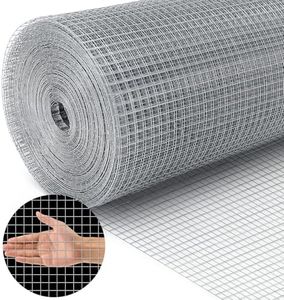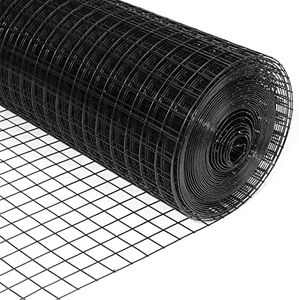We Use CookiesWe use cookies to enhance the security, performance,
functionality and for analytical and promotional activities. By continuing to browse this site you
are agreeing to our privacy policy
10 Best Hardware Cloth
From leading brands and best sellers available on the web.By clicking on a link to a third party's website, log data is shared with that third party.
Buying Guide for the Best Hardware Cloth
When choosing hardware cloth, it's important to think about what you'll use it for and where you'll install it. Hardware cloth is a type of wire mesh that's used for things like animal enclosures, garden protection, or home repair. The right hardware cloth will offer the strength, flexibility, and protection you need for your intended task. By understanding the most important features—such as mesh size, wire gauge, material, and coating—you can confidently select the best fit for your project.Mesh SizeMesh size refers to the size of the openings in the hardware cloth, usually measured in inches. This is important because it determines what can pass through the mesh. Common mesh sizes are 1/4 inch, 1/2 inch, and 1 inch. Smaller mesh sizes, like 1/4 inch, are good for keeping out tiny pests and ensuring a more secure barrier, especially for gardens or small animal enclosures. Larger mesh sizes allow for more airflow but are less secure against small intruders. To choose the right size, consider what you want to keep in or out—a smaller mesh keeps out more, while a larger mesh is sufficient when only bigger animals or objects are a concern.
Wire GaugeWire gauge refers to the thickness of the wire, with a lower number meaning thicker wire. This is a key factor in how sturdy and durable the hardware cloth will be. Thicker wire (such as 16 or 19 gauge) offers more strength and is harder to cut or bend, making it good for animal enclosures that need more security. Thinner wire (higher gauge numbers, like 23 or 27) is lighter and easier to shape, but less strong. If you want more security or durability, go with a lower gauge. For tasks where flexibility is more important than strength, a higher gauge may be enough.
MaterialThe material of hardware cloth is usually galvanized steel, stainless steel, or occasionally a plastic-coated variety. This matters for durability, rust resistance, and overall longevity, especially if it’s used outdoors. Galvanized steel is common, offering good rust resistance at a moderate cost. Stainless steel lasts even longer in harsh environments, but costs more. Plastic-coated types provide an extra layer of weather-proofing. If you’re using hardware cloth outside or in damp conditions, prioritize rust-resistant materials.
Coating TypeThe coating on hardware cloth refers to how it’s treated to resist rust and damage. Can be galvanized before or after the wire is woven, or have a vinyl/plastic coating. Pre-galvanized options are protected before forming, while post-galvanized gives a thick layer after shaping for even better protection. Vinyl-coated cloth is best for extreme weather or frequent contact with moisture. Choose the coating based on whether your climate is wet, whether the cloth will be buried, or how much exposure to the elements it will face.
Roll Size and DimensionsThe dimensions of hardware cloth rolls determine how much you get and how large an area you can cover. Roll widths and lengths can vary, so it’s important to measure your project area before buying. Choose a width that minimizes the number of seams, and a length that covers your space with as little waste as possible. Planning ahead can save you time and effort during installation, making your project more efficient.








